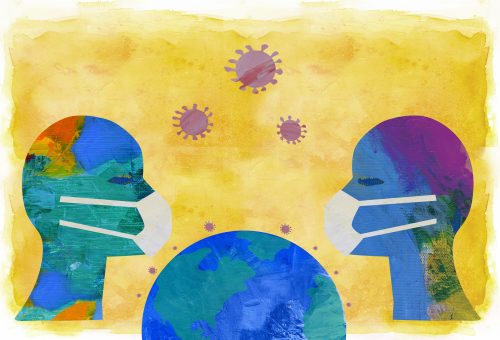What role do the arts play in medicine? When we first started medical school at the University of Michigan, neither of us could imagine that the arts would play a significant role during our four years here. We both came from undergraduate institutions with science-focused degrees, where art had been a hobby rather than an academic interest. However, over the last four years we have discovered a vibrant art and humanities scene that exists here at UMMS. Within it, we have found a community that seeks to bridge the gap between the arts and humanities and medicine. Now as we finish our last weeks of medical school, we can both agree that our exploration of this intersection has been a defining experience in our paths to becoming physicians.
At UMMS, we’re fortunate to have a robust Medical Arts Program that aims to help trainees provide more humanistic care through the study and reflection of the arts. This, and other programs like it in medical schools across the country are supported by increasing research that shows the benefits of art and the humanities in fostering important clinical skills. The Medical Arts Program at UMMS hosts a variety of extracurricular programs that include trips to local museums, musical performances, and opportunities for students to create their own art while reflecting on their experiences in healthcare. However, within the Medical Arts program, we thought there was space for more curricular medical humanities opportunities; this was the foundation behind our idea to create a formal elective experience for medical students at UMMS that similarly focuses on bridging the intersection between medicine and the arts: an elective called ‘Visual Arts in Medicine.’
Once this idea was born, we started with a needs assessment to look at the interest for a visual arts in medicine course amongst our peers. What we found was that many students felt that there was room for more curricular opportunities centered around the medical humanities. Once we knew a demand existed, we delved deeper into the literature and were excited to find that visual arts courses already existed at several medical schools across the country including Columbia, Harvard, Baylor, and more. Many of these courses focused on the connection between the visual arts and improving student’s objective observational skills used in clinical practice. However, when considering the breadth of our course, we decided that instead of covering one specific aspect of the medical arts in depth, we wanted our course to explore a broad number of ways in which art and medicine intersect. Our hope is to spotlight a wide variety of topics in this field and to spark an interest that may drive students to further embrace and explore the medical arts and humanities.
Our course is a two-week elective that will be piloted this month. It consists of 10 sessions, each focusing on a different aspect of art and the ways in which they can help us grow and develop as physicians. Sessions cover a wide range of topics from ‘graphic medicine’ and ‘art therapy’ to ‘plagues and pandemics in art’. Our course is sponsored by the Medical Arts Program, and we are supported by its incredible faculty leadership including Dr. Joel Howell and Dr. Lona Mody. Through designing this course, we have also been able to connect with an interdisciplinary group of individuals across the University of Michigan including art therapists, physicians, and graphic medicine artists, who do amazing work that intersects both medicine and the arts.
We have learned so much through this whole experience and are excited to see our course kick off. We consider ourselves very fortunate to have connected with such a rich medical arts community within the University of Michigan, and we hope that this course will allow other students to do the same. This whole process has been very empowering for us as students as well. When we decided to pursue this path in order to explore an area that we were passionate about, we were met with wholehearted support and encouragement. We found that as students here at UMMS, we have access to the resources and mentors we need to pursue or create new experiences that reflect our unique interests in medicine.
Don’t miss the next Dose of Reality.
Gavisha is a fourth-year medical student at the University of Michigan Medical School. She will be starting an Internal Medicine residency at The Ohio State University this summer. She enjoys hiking, making art, and playing with her friends’ pets.
Sangri is a fourth-year medical student at the University of Michigan Medical School. Her academic interests include quality improvement, medical education, and the medical arts and humanities, which overlaps with her personal interest in the arts. She will be starting her residency in Neurology at Northwestern University in July.
